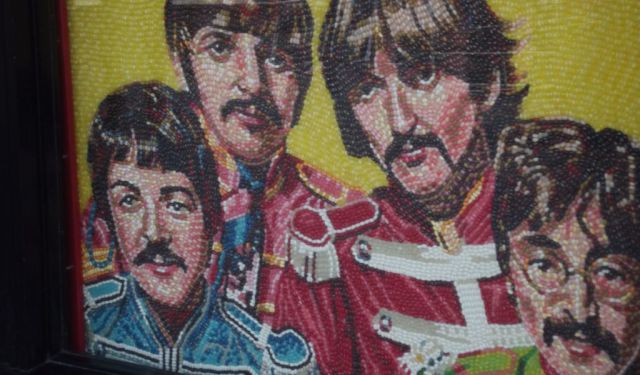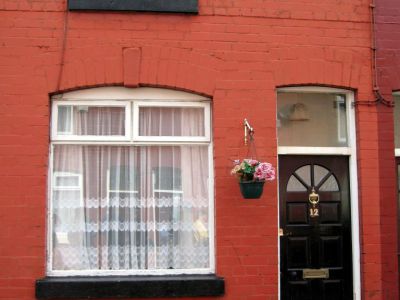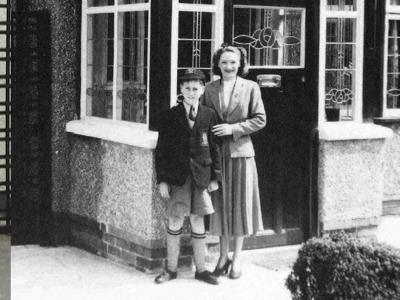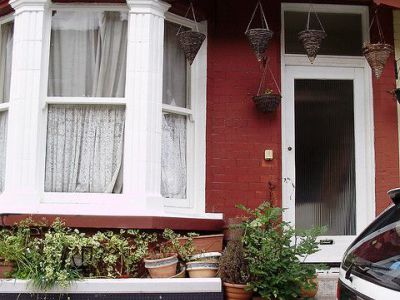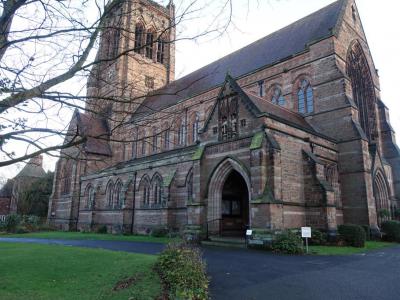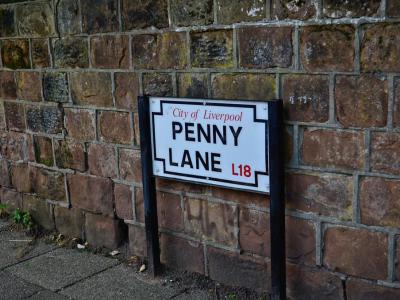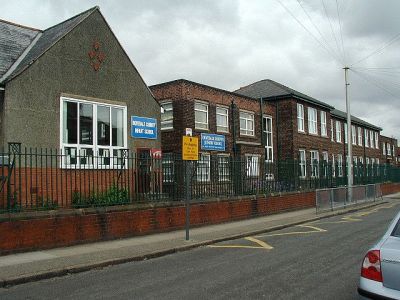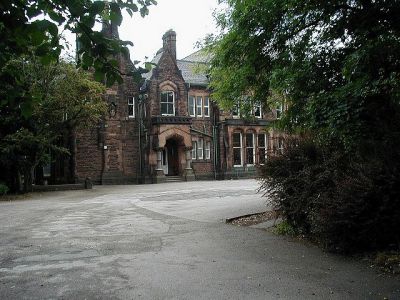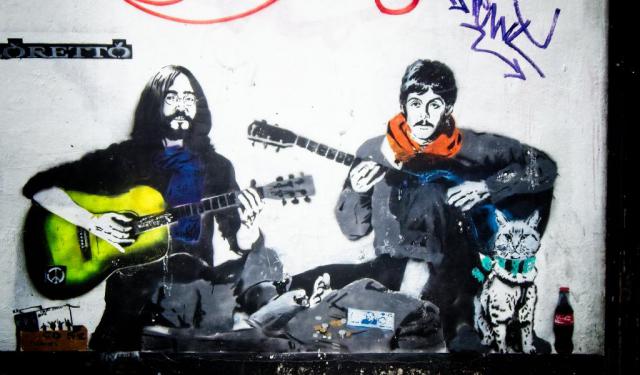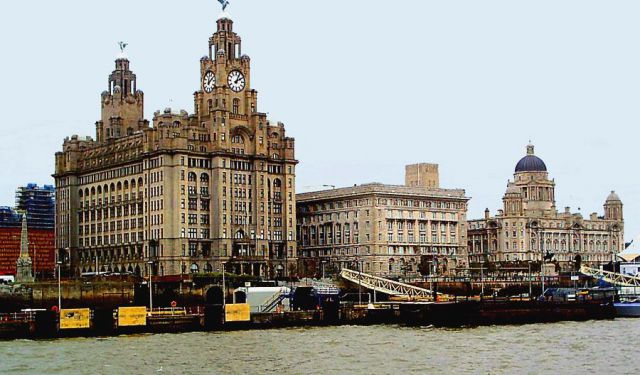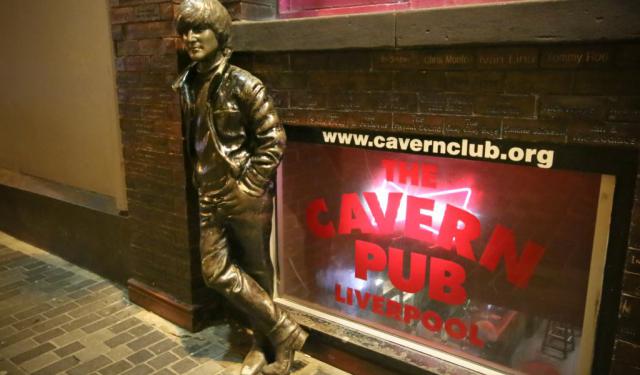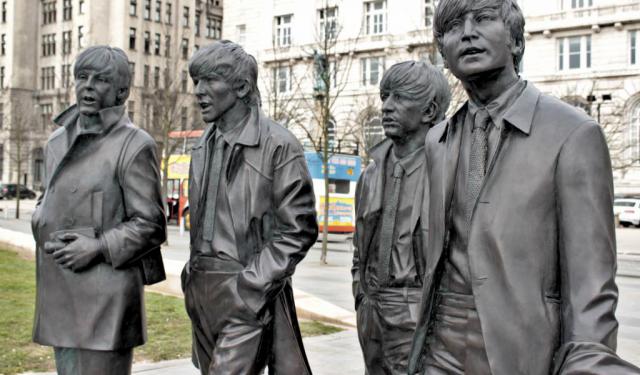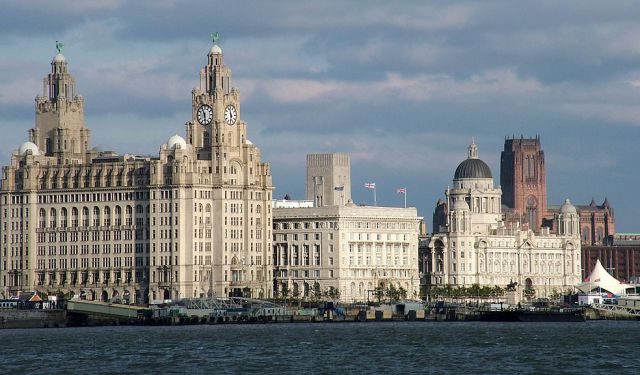Beatles Tour in Liverpool, Part II (Self Guided), Liverpool
Liverpool is permeated with The Beatles who seem to be everywhere! There are so many places associated with the band in the city: childhood homes, schools, bars... Some of them are rather unassuming, at a glance, and thus can be easily overlooked.
George Harrison's Birthplace, located at 12 Arnold Grove, is where the lead guitarist of The Beatles was born on February 25, 1943. Despite its unglamorous past and private status, this modest suburban house continues to draw Beatles fans from all over the world.
Moving on to John Lennon, Mosspits Lane Infants School, attended by young John from November 1945 until May 1946, is another significant spot. The legendary musician's home at 9 Newcastle Road is where John lived with his parents for the first two years of his life.
Nearby, Saint Barnabas Church is known for its association with Paul McCartney; he frequented it and even sang in the choir, which also adds to The Beatles lore.
Penny Lane, immortalized in the famous song, is a must-visit location. This quiet street inspired one of The Beatles' most iconic tracks and is filled with references from the song.
Dovedale Primary School, where John Lennon and George Harrison attended, is not far off, offering insight into the childhood of these musical legends.
Lastly, Quarry Bank Grammar School, now known as Calderstones School, is where John Lennon studied and eventually formed the band called "The Quarrymen," joined by Paul McCartney, George Harrison, and Stuart Sutcliffe under the encouragement of the school's headmaster.
For any Beatles fan, visiting these landmarks in Liverpool is like stepping into the band's history. It's a chance to walk in the footsteps of musical giants and experience the places that shaped their lives and music. So, if you find yourself in Liverpool, don't miss the opportunity to explore these Beatles locations and immerse yourself in the magic of their legacy.
George Harrison's Birthplace, located at 12 Arnold Grove, is where the lead guitarist of The Beatles was born on February 25, 1943. Despite its unglamorous past and private status, this modest suburban house continues to draw Beatles fans from all over the world.
Moving on to John Lennon, Mosspits Lane Infants School, attended by young John from November 1945 until May 1946, is another significant spot. The legendary musician's home at 9 Newcastle Road is where John lived with his parents for the first two years of his life.
Nearby, Saint Barnabas Church is known for its association with Paul McCartney; he frequented it and even sang in the choir, which also adds to The Beatles lore.
Penny Lane, immortalized in the famous song, is a must-visit location. This quiet street inspired one of The Beatles' most iconic tracks and is filled with references from the song.
Dovedale Primary School, where John Lennon and George Harrison attended, is not far off, offering insight into the childhood of these musical legends.
Lastly, Quarry Bank Grammar School, now known as Calderstones School, is where John Lennon studied and eventually formed the band called "The Quarrymen," joined by Paul McCartney, George Harrison, and Stuart Sutcliffe under the encouragement of the school's headmaster.
For any Beatles fan, visiting these landmarks in Liverpool is like stepping into the band's history. It's a chance to walk in the footsteps of musical giants and experience the places that shaped their lives and music. So, if you find yourself in Liverpool, don't miss the opportunity to explore these Beatles locations and immerse yourself in the magic of their legacy.
How it works: Download the app "GPSmyCity: Walks in 1K+ Cities" from Apple App Store or Google Play Store to your mobile phone or tablet. The app turns your mobile device into a personal tour guide and its built-in GPS navigation functions guide you from one tour stop to next. The app works offline, so no data plan is needed when traveling abroad.
Beatles Tour in Liverpool, Part II Map
Guide Name: Beatles Tour in Liverpool, Part II
Guide Location: England » Liverpool (See other walking tours in Liverpool)
Guide Type: Self-guided Walking Tour (Sightseeing)
# of Attractions: 7
Tour Duration: 2 Hour(s)
Travel Distance: 4.1 Km or 2.5 Miles
Author: irenes
Sight(s) Featured in This Guide:
Guide Location: England » Liverpool (See other walking tours in Liverpool)
Guide Type: Self-guided Walking Tour (Sightseeing)
# of Attractions: 7
Tour Duration: 2 Hour(s)
Travel Distance: 4.1 Km or 2.5 Miles
Author: irenes
Sight(s) Featured in This Guide:
- George Harrison's Birthplace
- Mosspits Lane Infants School
- The First Home of John Lennon
- St. Barnabas Church
- Penny Lane
- Dovedale Primary School
- Quarry Bank Grammar School
1) George Harrison's Birthplace
George Harrison, lead guitarist of the legendary Liverpudlian rock band The Beatles, was born at 12 Arnold Grove, in the Wavertree area of the city. The modest two-storey terraced house, tucked away in a suburban cul-de-sac, is a world away from the fame and fortune Harrison found with the Beatles’ astonishing trans-Atlantic success. Harrison’s parents first rented the house in 1930, and paid just ten shillings, or around a dollar, in rent per week. George was the fourth Harrison child, and was born in the house in 1943, at the height of German aerial attacks on the city.
The house at 12 Arnold Grove no longer houses members of the Harrison family. They moved to a new council property when George was seven years old. In his autobiography, the famously spiritual guitarist recalled a tough upbringing in the home, with only a coal fire for heating, an outside toilet and rooms measuring just ten feet squared. Harrison is quoted as saying that, despite the cramped, unglamorous surroundings, the house was a happy family home for him and his siblings. Despite remaining a private residence, 12 Arnold Grove draws hundreds of Beatles fans each year, particularly following Harrison’s untimely death in 2001.
The house at 12 Arnold Grove no longer houses members of the Harrison family. They moved to a new council property when George was seven years old. In his autobiography, the famously spiritual guitarist recalled a tough upbringing in the home, with only a coal fire for heating, an outside toilet and rooms measuring just ten feet squared. Harrison is quoted as saying that, despite the cramped, unglamorous surroundings, the house was a happy family home for him and his siblings. Despite remaining a private residence, 12 Arnold Grove draws hundreds of Beatles fans each year, particularly following Harrison’s untimely death in 2001.
2) Mosspits Lane Infants School
Located on Woolton Road in Wavertree, Liverpool, Mosspits Lane Infants School holds a significant place in Beatles history as the first school John Lennon attended. Enrolled on November 12, 1945, young John, then only five years old, spent six months here before moving on to Dovedale Primary School in May 1946.
At the time, John lived a short walk away on Newcastle Road. His mother, Julia Lennon, who was raising him alone, managed to balance her responsibilities by taking up a part-time job at a nearby café. She would walk John to school in the mornings and pick him up after her lunchtime shift at the Coffee House public house on Church Road. Despite being one of many pupils, John stood out from the beginning. His teachers noted his exceptional talents in reading, writing, and art-skills that hinted at his creative potential.
Even as a child, Lennon exhibited an early knack for storytelling and drawing. By the age of seven, he had written his first "book," and by eleven, he was creating sketches and jokes. This artistic inclination would later surface in his contributions to The Beatles and his solo career, notably in his drawings featured on the Walls and Bridges album.
Mosspits Lane Infants School also boasts a connection to other future Beatles-related figures. Among its pupils were Len Garry, Pete Shotton, and Nigel Walley, who would later form part of The Quarrymen, the skiffle band that evolved into The Silver Beatles and eventually The Beatles. This early association underscores the school's place in the origins of one of the world’s most iconic bands.
Today, Mosspits Lane Infants School remains a point of interest for Beatles fans, offering a glimpse into the formative years of one of music’s greatest legends. It was here, in a modest classroom, that the seeds of John Lennon's remarkable journey began to take root.
At the time, John lived a short walk away on Newcastle Road. His mother, Julia Lennon, who was raising him alone, managed to balance her responsibilities by taking up a part-time job at a nearby café. She would walk John to school in the mornings and pick him up after her lunchtime shift at the Coffee House public house on Church Road. Despite being one of many pupils, John stood out from the beginning. His teachers noted his exceptional talents in reading, writing, and art-skills that hinted at his creative potential.
Even as a child, Lennon exhibited an early knack for storytelling and drawing. By the age of seven, he had written his first "book," and by eleven, he was creating sketches and jokes. This artistic inclination would later surface in his contributions to The Beatles and his solo career, notably in his drawings featured on the Walls and Bridges album.
Mosspits Lane Infants School also boasts a connection to other future Beatles-related figures. Among its pupils were Len Garry, Pete Shotton, and Nigel Walley, who would later form part of The Quarrymen, the skiffle band that evolved into The Silver Beatles and eventually The Beatles. This early association underscores the school's place in the origins of one of the world’s most iconic bands.
Today, Mosspits Lane Infants School remains a point of interest for Beatles fans, offering a glimpse into the formative years of one of music’s greatest legends. It was here, in a modest classroom, that the seeds of John Lennon's remarkable journey began to take root.
3) The First Home of John Lennon
The first home of John Lennon, The Beatles' singer, songwriter and guitarist, and one of the 20th century most respected musical figures, is found in the eastern suburb of Wavertree. 9 Newcastle Road, a red brick terraced house, is located just a fifteen minute walk from George Harrison’s childhood home on Arnold Grove. Lennon was not born at the house, but at the Liverpool Maternity Hospital, in October 1940. He lived here only as a very young child; his parents, Alfred and Julia Lennon, moved to another home in the city in 1942.
John Lennon, the first and only child of his parents, suffered a difficult upbringing from his very first days at 9 Newcastle Road. His father was a merchant seaman, frequently away from home, and his mother Julia struggled to cope when he was absent, cutting the supply of pay cheques to the family home. Lennon’s aunt, Mimi Smith, ultimately raised concerns with the local Social Services department and, eventually, Lennon went to live with her and his uncle at the Mendips, a semi-detached suburban house he saw as his permanent childhood home. Lennon praised the role of his aunt and mother in his upbringing, and many consider his troubled mother to be one of the greatest influences on his work.
John Lennon, the first and only child of his parents, suffered a difficult upbringing from his very first days at 9 Newcastle Road. His father was a merchant seaman, frequently away from home, and his mother Julia struggled to cope when he was absent, cutting the supply of pay cheques to the family home. Lennon’s aunt, Mimi Smith, ultimately raised concerns with the local Social Services department and, eventually, Lennon went to live with her and his uncle at the Mendips, a semi-detached suburban house he saw as his permanent childhood home. Lennon praised the role of his aunt and mother in his upbringing, and many consider his troubled mother to be one of the greatest influences on his work.
4) St. Barnabas Church
Saint Barnabas is a church in the Liverpool suburbs, made famous by the street it stands on – Penny Lane – that served as an inspiration for one of the Beatles’ best loved songs. The church was frequented by the Beatles songwriter and bass player, Paul McCartney, who at one point was even a member of the local choir. The church once had a hall further down the lane, which once played host to a gig from the fledging Beatles. The church welcomes Beatles fans from all over the world each year, and includes a wry nod to the band even in its service – the altar is emblazoned with the famous Beatles lyric “We Can Work It Out”.
Saint Barnabas is an Anglican church, serving the Mossley Hill parish. It has existed in its current location since 1914, having previously been housed in a temporary iron building, of which there were many in the early 20th century. The church holds communion on Sundays at 8.30am, 10.30am and 6.30pm, and on Thursdays at 10.00am. There is also a morning prayer service on Tuesdays at 7.15am. If you would like to tread in the footsteps of Paul McCartney, and can hold a tune, the Saint Barnabas Choir is still in operation and meets every Thursday evening at the church.
Saint Barnabas is an Anglican church, serving the Mossley Hill parish. It has existed in its current location since 1914, having previously been housed in a temporary iron building, of which there were many in the early 20th century. The church holds communion on Sundays at 8.30am, 10.30am and 6.30pm, and on Thursdays at 10.00am. There is also a morning prayer service on Tuesdays at 7.15am. If you would like to tread in the footsteps of Paul McCartney, and can hold a tune, the Saint Barnabas Choir is still in operation and meets every Thursday evening at the church.
5) Penny Lane
Penny Lane, a fairly typical suburban shopping street in the eastern suburb of Mossley Hill, has become world famous thanks to the Beatles hit that bears its name. It was written by Paul McCartney, who attended Saint Barnabas Church on the street and often met here his childhood friend and fellow Beatle, John Lennon, before catching a bus to Liverpool’s city centre. The many sights referenced in the lyrics can still be found on Penny Lane, including a bus shelter, a barber shop and a fire station. Street signs bearing the famous name were stolen so regularly that the council began painting the street name onto buildings instead.
“Penny Lane” was released in 1967 as a double A-side single with “Strawberry Fields Forever”, another song which references a Liverpool landmark. Beatles producer, George Martin, believed that it was collectively their finest single. It went to No.1 in the US, but only reached No.2 in the UK charts. The street has grown in stature as the result of its Beatles connections, and has become an attraction for tourists and locals alike. It caused some embarrassment to the council officials at one point, when they proposed that all Liverpool streets named after slave traders be renamed, unaware that Penny Lane was indeed named after the local slave trader James Penny. The famous street thus kept its name, whilst the other street names in the city were changed.
“Penny Lane” was released in 1967 as a double A-side single with “Strawberry Fields Forever”, another song which references a Liverpool landmark. Beatles producer, George Martin, believed that it was collectively their finest single. It went to No.1 in the US, but only reached No.2 in the UK charts. The street has grown in stature as the result of its Beatles connections, and has become an attraction for tourists and locals alike. It caused some embarrassment to the council officials at one point, when they proposed that all Liverpool streets named after slave traders be renamed, unaware that Penny Lane was indeed named after the local slave trader James Penny. The famous street thus kept its name, whilst the other street names in the city were changed.
6) Dovedale Primary School
Dovedale Primary School is a prominent mixed-community primary school located on Herondale Road in the Mossley Hill district of Liverpool. Established in 1908, the school has evolved from its original structure as two separate institutions-Dovedale Junior School and Dovedale Infant School-into a unified educational establishment as of September 2015. This merger was formally recognized by the Department for Education, consolidating the schools' management and resources under the banner of Dovedale Primary School.
Dovedale Primary School holds a unique place in cultural history as the educational starting point for several notable figures, most famously George Harrison and John Lennon of The Beatles. Lennon's close friend Pete Shotton also attended the school, further intertwining its legacy with the iconic band. Other distinguished alumni include comedian Jimmy Tarbuck and renowned newsreader Peter Sissons.
During the 1950s, Dovedale earned a strong reputation as a "feeder" school for prestigious Liverpool grammar schools such as Quarry Bank High School, the Liverpool Institute for Boys, and the Liverpool Blue Coat School. This track record underscored the school’s commitment to academic excellence and the success of its students in higher education pathways.
In 2001, the school received a generous donation of £25,000 from Yoko Ono, the widow of John Lennon. This contribution was earmarked for refurbishments, reflecting her enduring connection to Lennon’s early life and the community that shaped his formative years.
Today, Dovedale Primary School continues to serve the Mossley Hill community, offering a nurturing environment for its mixed student body. The school's historical legacy, combined with its commitment to fostering academic and personal growth, makes it a cornerstone of the local educational landscape and a cultural landmark in Liverpool.
Dovedale Primary School holds a unique place in cultural history as the educational starting point for several notable figures, most famously George Harrison and John Lennon of The Beatles. Lennon's close friend Pete Shotton also attended the school, further intertwining its legacy with the iconic band. Other distinguished alumni include comedian Jimmy Tarbuck and renowned newsreader Peter Sissons.
During the 1950s, Dovedale earned a strong reputation as a "feeder" school for prestigious Liverpool grammar schools such as Quarry Bank High School, the Liverpool Institute for Boys, and the Liverpool Blue Coat School. This track record underscored the school’s commitment to academic excellence and the success of its students in higher education pathways.
In 2001, the school received a generous donation of £25,000 from Yoko Ono, the widow of John Lennon. This contribution was earmarked for refurbishments, reflecting her enduring connection to Lennon’s early life and the community that shaped his formative years.
Today, Dovedale Primary School continues to serve the Mossley Hill community, offering a nurturing environment for its mixed student body. The school's historical legacy, combined with its commitment to fostering academic and personal growth, makes it a cornerstone of the local educational landscape and a cultural landmark in Liverpool.
7) Quarry Bank Grammar School
The young troublemaker John Lennon studied at the Quarry Bank Grammar School between 1952 and 1957. John's closest friend, Pete Shotton, also frequented Quarry Bank Grammar. Together, they broke all the rules: smoking, fighting, swearing, and so on.
In 1956, John form a band calling it The Quarrymen. Interestingly, the name "Quarrymen" was not taken from the school name, but from the Quarry Bank School song titled, "The Song Of The Quarry". The initial band consisted of John Lennon, Pete Shotton, Ron Davis, Len Garry, Colin Hatton, and Eric Griffiths. Nobody, except John, took the band seriously. Paul McCartney joined The Quarrymen in July 1957, followed later by George Harrison and Stuart Sutcliffe.
In the same year when Quarrymen was formed, Ernest Pobjoy became the headmaster of the school. He allowed the band to play in the building's hall. He was the person who encouraged John in his interest in music and recommended him to the Liverpool College of Art.
In 1956, John form a band calling it The Quarrymen. Interestingly, the name "Quarrymen" was not taken from the school name, but from the Quarry Bank School song titled, "The Song Of The Quarry". The initial band consisted of John Lennon, Pete Shotton, Ron Davis, Len Garry, Colin Hatton, and Eric Griffiths. Nobody, except John, took the band seriously. Paul McCartney joined The Quarrymen in July 1957, followed later by George Harrison and Stuart Sutcliffe.
In the same year when Quarrymen was formed, Ernest Pobjoy became the headmaster of the school. He allowed the band to play in the building's hall. He was the person who encouraged John in his interest in music and recommended him to the Liverpool College of Art.
Walking Tours in Liverpool, England
Create Your Own Walk in Liverpool
Creating your own self-guided walk in Liverpool is easy and fun. Choose the city attractions that you want to see and a walk route map will be created just for you. You can even set your hotel as the start point of the walk.
Beatles Tour in Liverpool, Part III
Now that you have been to a good number of spots around Liverpool associated with The Beatles, it is high time to explore the “early days” of the Fab Four in their hometown and see where it all started.
One such place is Strawberry Field, immortalized in their song "Strawberry Fields Forever." It was a Salvation Army children's home, and although the original building no... view more
Tour Duration: 2 Hour(s)
Travel Distance: 5.3 Km or 3.3 Miles
One such place is Strawberry Field, immortalized in their song "Strawberry Fields Forever." It was a Salvation Army children's home, and although the original building no... view more
Tour Duration: 2 Hour(s)
Travel Distance: 5.3 Km or 3.3 Miles
Liverpool Historical Sites Walking Tour
For a city steeped in history and culture as much as Liverpool, it is only natural to have many historical sites illustrative of its glorious past. Three of Liverpool's most remarkable buildings, collectively known as the Three Graces of Liverpool, are situated in the Pier Head. These include the Royal Liver Building, the Cunard Building, and the Port of Liverpool Building.
The... view more
Tour Duration: 1 Hour(s)
Travel Distance: 1.3 Km or 0.8 Miles
The... view more
Tour Duration: 1 Hour(s)
Travel Distance: 1.3 Km or 0.8 Miles
Beatles Pub Crawl
Alright, so you're in Liverpool, the hometown of The Beatles, and you're thirsty. There are lots of pubs in Liverpool, all different in character, with some claiming that The Beatles drank or played there at some point.
Indeed, the lads performed in many small venues throughout the city, but the joints they usually played were not the ones they liked for their drinks. Now, if... view more
Tour Duration: 1 Hour(s)
Travel Distance: 1.8 Km or 1.1 Miles
Indeed, the lads performed in many small venues throughout the city, but the joints they usually played were not the ones they liked for their drinks. Now, if... view more
Tour Duration: 1 Hour(s)
Travel Distance: 1.8 Km or 1.1 Miles
Beatles Tour in Liverpool, Part I
The hometown of Paul McCartney, John Lennon, George Harrison, and Ringo Star, Liverpool is called “The Beatles Capital” for a reason. The city saw the dawn of the Fabulous Four's musical career and is brimming with Beatlemania: Beatles-themed bars, restaurants, hotels, and other places associated with the iconic band.
The Beatles Story, an immersive museum, chronicles the Fab... view more
Tour Duration: 2 Hour(s)
Travel Distance: 4.0 Km or 2.5 Miles
The Beatles Story, an immersive museum, chronicles the Fab... view more
Tour Duration: 2 Hour(s)
Travel Distance: 4.0 Km or 2.5 Miles
Liverpool Introduction Walking Tour
Famously, the hometown (aka the “capital”) of the Beatles, Liverpool is more than just the Fab Four. Closely associated with the arts, music, culture, and architecture, as well as industrial innovation, the city is renowned for its multitude of historic landmarks, world-class sport arenas and shopping/entertainment. The abundance of art galleries, national museums and listed attractions in... view more
Tour Duration: 2 Hour(s)
Travel Distance: 3.6 Km or 2.2 Miles
Tour Duration: 2 Hour(s)
Travel Distance: 3.6 Km or 2.2 Miles
The Most Popular Cities
/ view all
